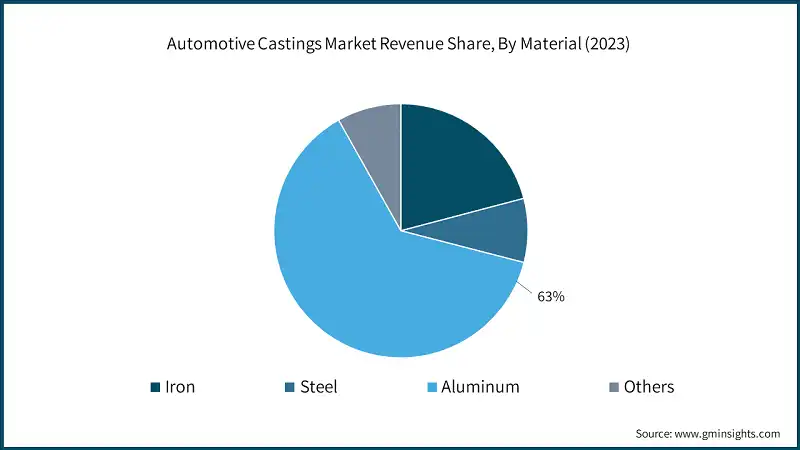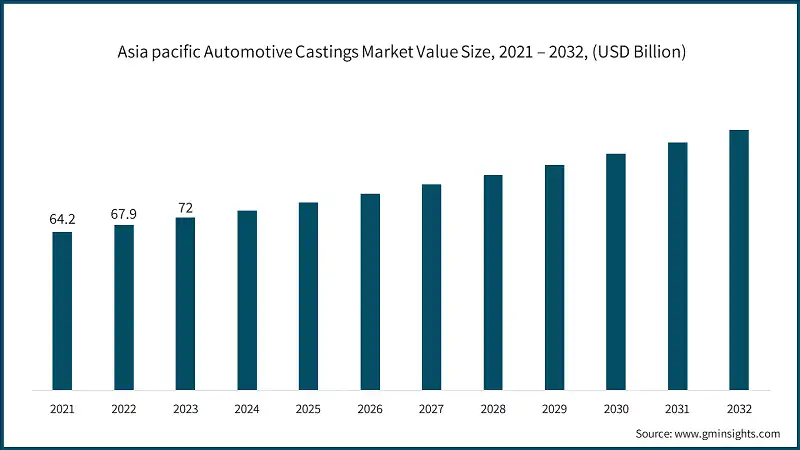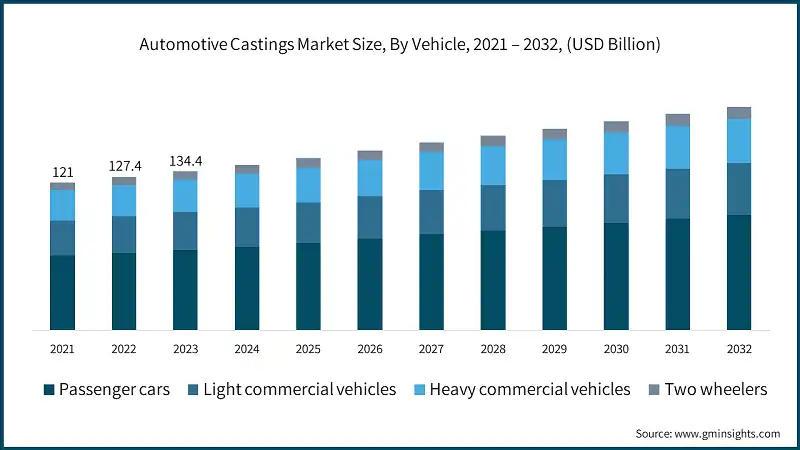Home > Automotive > Automotive Materials > Metals > Automotive Casting Market
Automotive Casting Market Analysis
- Report ID: GMI5052
- Published Date: Aug 2024
- Report Format: PDF
Automotive Casting Market Analysis
Based on vehicle type, the market is segmented into Passenger cars, Light commercial vehicles, Heavy commercial vehicles and Two wheelers. In 2023 passenger cars dominated the market generating a revenue exceeding USD 65 billion and is expected to reach more than USD 105.1 billion by 2032. Passenger vehicles lead the automotive casting market due to their high production volumes and strong consumer demand. The large-scale production of passenger cars drives significant demand for cast components like engine blocks, transmission cases, and structural parts. This segment is quick to adopt advanced casting technologies and materials, driven by consumer preferences for better performance, fuel efficiency, and safety.
Strict regulations on fuel efficiency and emissions also push the need for innovative casting solutions. Additionally, the passenger vehicle market benefits from ongoing customization and frequent model updates, which create a continuous need for specialized cast components. The steady aftermarket demand for replacement parts and repairs further strengthens the dominance of passenger vehicles in the casting market. These factors collectively make the passenger vehicle segment a key driver of growth and innovation in the market.

Based on material type the automotive casting market is segmented as Iron, steel, aluminum and others. The aluminum material emerged as the dominant segment holding a market share of 63% and is anticipated to grow at a CAGR of 5.8% through 2032. Aluminum leads the market due to its lightweight, which reduces vehicle weight and improves fuel efficiency. This aligns with the industry's focus on sustainability and stricter environmental regulations. Its high strength-to-weight ratio ensures durability and safety, while its corrosion resistance increases the lifespan of automotive parts.
Aluminum's flexibility allows for casting complex shapes, making it ideal for innovative automotive components. Additionally, its excellent recyclability supports the industry's goal of reducing environmental impact. Despite a higher initial cost, aluminum's benefits in fuel savings and durability, along with advancements in casting technologies, make it prevalent in the market.

Asia pacific automotive casting market size dominated around USD 72 billion in 2023 and is expected to reach USD 119.16 billion by 2032. Rapid industrialization and urbanization in countries like China and India have increased vehicle production and demand. The region's strong automotive manufacturing base, supported by many original equipment manufacturers (OEMs) and suppliers, drives market growth.
Additionally, Asia-Pacific countries are investing heavily in technology and infrastructure, enhancing their casting capabilities. Lower labor and production costs also give the region a competitive edge. Government policies and incentives to boost the automotive sector, along with a focus on producing lighter and more fuel-efficient vehicles, further strengthen Asia-Pacific's dominance in the market.
North America: The U.S. dominated the North America automotive casting market with a share of 84.29% and is anticipated to grow at a CAGR of 5.4% during the forecasted period. This dominance is due to the region featuring major manufacturers and suppliers. This strong industry drives high demand for casting components needed in vehicle production. The region benefits from a well-established supply chain and advanced manufacturing capabilities, ensuring efficient production and distribution of these components. Continuous growth and innovation in the automotive sector increase the need for high-quality casting solutions to meet changing demands.
Europe: Germany led the Europe automotive casting market with a revenue of around 27.66% and is anticipated to grow at a CAGR of 5.2% during the forecasted period. Germany is a global leader in automotive manufacturing, with major OEMs like Volkswagen, BMW, and Mercedes-Benz. This strong automotive sector drives high demand for advanced casting solutions, especially for high-performance and precision-engineered components. The country's focus on innovation, strict environmental regulations, and the shift towards electric vehicles further increases the need for advanced casting materials. With its emphasis on sustainability and manufacturing excellence, Germany remains a key player in the market, supporting the development of high-quality, efficient, and eco-friendly automotive components.
Asia Pacific: China dominated the Asia Pacific automotive casting market with a market share of 54.58% and is anticipated to grow at a CAGR of 6.6% during the forecast period. China's government is promoting electric vehicles (EVs) through subsidies and policy support. This shift to EVs increases the need for lightweight components to improve battery efficiency and vehicle performance, driving demand for aluminum and other lightweight castings. This focus on EVs aligns with China's environmental goals and supports the growth of advanced casting technologies needed for high-performance, energy-efficient components.

